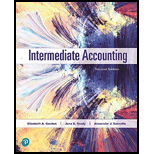
Intermediate Accounting (2nd Edition)
2nd Edition
ISBN: 9780134730370
Author: Elizabeth A. Gordon, Jana S. Raedy, Alexander J. Sannella
Publisher: PEARSON
expand_more
expand_more
format_list_bulleted
Question
Chapter 14, Problem 14.17BE
To determine
The issue price of the bond and prepare amortization table.
Given information:
Company issued bonds worth $1,500,000.
Term period for conversion is 7 years.
Interest is payable semi-annually each January 1 and July 1.
Market rate of interest is 8%.
Expert Solution & Answer
Want to see the full answer?
Check out a sample textbook solution
Students have asked these similar questions
None
Not need ai solution please solve this general accounting question
Financial accounting
Chapter 14 Solutions
Intermediate Accounting (2nd Edition)
Ch. 14 - What conditions or terms does a note payable...Ch. 14 - If the market rate of interest exceeds the face or...Ch. 14 - What is included in bond issue costs and how...Ch. 14 - Prob. 14.4QCh. 14 - When a bond is issued at a discount, will its...Ch. 14 - Prob. 14.6QCh. 14 - Prob. 14.7QCh. 14 - Under IFRS, how do firms account for convertible...Ch. 14 - Prob. 14.9QCh. 14 - Can companies reclassify short-term debt expected...
Ch. 14 - Under IFRS, can companies reclassify short-term...Ch. 14 - Do companies always reclassify long-term debt that...Ch. 14 - Prob. 14.13QCh. 14 - Prob. 14.14QCh. 14 - Prob. 14.15QCh. 14 - Prob. 14.16QCh. 14 - Prob. 14.1MCCh. 14 - Prob. 14.2MCCh. 14 - Prob. 14.3MCCh. 14 - Prob. 14.4MCCh. 14 - Prob. 14.5MCCh. 14 - Clothes Horse Corp. (CHC) Issued 500,000 bonds due...Ch. 14 - Prob. 14.7MCCh. 14 - Prob. 14.8MCCh. 14 - Prob. 14.9MCCh. 14 - Prob. 14.10MCCh. 14 - Prob. 14.11MCCh. 14 - Prob. 14.1BECh. 14 - Notes Payable. Using the information provided in...Ch. 14 - Prob. 14.3BECh. 14 - Prob. 14.4BECh. 14 - Prob. 14.5BECh. 14 - Prob. 14.6BECh. 14 - Bond Terminology. Match each term with its...Ch. 14 - Bond Pricing. Fill in the missing items for each...Ch. 14 - Prob. 14.9BECh. 14 - Bond Issue Price. Using the information from...Ch. 14 - Prob. 14.11BECh. 14 - Prob. 14.12BECh. 14 - Prob. 14.13BECh. 14 - Prob. 14.14BECh. 14 - Prob. 14.15BECh. 14 - Prob. 14.16BECh. 14 - Prob. 14.17BECh. 14 - Prob. 14.18BECh. 14 - Bonds Issued between Interest Payment Dates. For...Ch. 14 - Prob. 14.20BECh. 14 - Prob. 14.21BECh. 14 - Prob. 14.22BECh. 14 - Prob. 14.23BECh. 14 - Prob. 14.24BECh. 14 - Prob. 14.25BECh. 14 - Prob. 14.26BECh. 14 - Prob. 14.27BECh. 14 - Prob. 14.28BECh. 14 - Prob. 14.29BECh. 14 - Prob. 14.30BECh. 14 - Short-Term Debt Expected to Be Refinanced, IFRS....Ch. 14 - Prob. 14.32BECh. 14 - Prob. 14.33BECh. 14 - Prob. 14.34BECh. 14 - Prob. 14.35BECh. 14 - Fair Value Option. Saratoga Company issued bonds...Ch. 14 - Prob. 14.37BECh. 14 - Financial Statement Disclosure. Use the following...Ch. 14 - Prob. 14.1ECh. 14 - Prob. 14.2ECh. 14 - Prob. 14.3ECh. 14 - Prob. 14.4ECh. 14 - Prob. 14.5ECh. 14 - Bond Issue, Interest Payments, Effective Interest...Ch. 14 - Prob. 14.7ECh. 14 - Prob. 14.8ECh. 14 - Prob. 14.9ECh. 14 - Prob. 14.10ECh. 14 - Prob. 14.11ECh. 14 - Prob. 14.12ECh. 14 - Convertible Bonds, Conversion. On January 1, 2018,...Ch. 14 - Convertible Bonds, Conversion. Using the...Ch. 14 - Prob. 14.15ECh. 14 - Prob. 14.16ECh. 14 - Prob. 14.17ECh. 14 - Prob. 14.18ECh. 14 - Warrants. DHC Associates issued 2,100 of its...Ch. 14 - Prob. 14.20ECh. 14 - Prob. 14.21ECh. 14 - Prob. 14.1PCh. 14 - Long-Term Notes Payable, Semiannual Interest,...Ch. 14 - Note Payable Issued at a Discount with...Ch. 14 - Prob. 14.4PCh. 14 - Prob. 14.5PCh. 14 - Bond Issue, Interest Payments, Effective Interest...Ch. 14 - Prob. 14.7PCh. 14 - Bonds Sold between Interest Dates at a Discount,...Ch. 14 - Prob. 14.9PCh. 14 - Prob. 14.10PCh. 14 - Convertible Bonds, Bond Issue Costs, Conversion....Ch. 14 - Prob. 14.12PCh. 14 - Prob. 14.13PCh. 14 - Prob. 1JCCh. 14 - Prob. 2JCCh. 14 - Prob. 3JCCh. 14 - Prob. 1FSCCh. 14 - Prob. 1SSCCh. 14 - Surfing the Standards Case 2: Bonds with...Ch. 14 - Prob. 1BCC
Knowledge Booster
Similar questions
arrow_back_ios
SEE MORE QUESTIONS
arrow_forward_ios
Recommended textbooks for you
 Intermediate Accounting: Reporting And AnalysisAccountingISBN:9781337788281Author:James M. Wahlen, Jefferson P. Jones, Donald PagachPublisher:Cengage Learning
Intermediate Accounting: Reporting And AnalysisAccountingISBN:9781337788281Author:James M. Wahlen, Jefferson P. Jones, Donald PagachPublisher:Cengage Learning Excel Applications for Accounting PrinciplesAccountingISBN:9781111581565Author:Gaylord N. SmithPublisher:Cengage Learning
Excel Applications for Accounting PrinciplesAccountingISBN:9781111581565Author:Gaylord N. SmithPublisher:Cengage Learning Financial AccountingAccountingISBN:9781337272124Author:Carl Warren, James M. Reeve, Jonathan DuchacPublisher:Cengage Learning
Financial AccountingAccountingISBN:9781337272124Author:Carl Warren, James M. Reeve, Jonathan DuchacPublisher:Cengage Learning Financial AccountingAccountingISBN:9781305088436Author:Carl Warren, Jim Reeve, Jonathan DuchacPublisher:Cengage Learning
Financial AccountingAccountingISBN:9781305088436Author:Carl Warren, Jim Reeve, Jonathan DuchacPublisher:Cengage Learning Financial Accounting: The Impact on Decision Make...AccountingISBN:9781305654174Author:Gary A. Porter, Curtis L. NortonPublisher:Cengage Learning
Financial Accounting: The Impact on Decision Make...AccountingISBN:9781305654174Author:Gary A. Porter, Curtis L. NortonPublisher:Cengage Learning

Intermediate Accounting: Reporting And Analysis
Accounting
ISBN:9781337788281
Author:James M. Wahlen, Jefferson P. Jones, Donald Pagach
Publisher:Cengage Learning

Excel Applications for Accounting Principles
Accounting
ISBN:9781111581565
Author:Gaylord N. Smith
Publisher:Cengage Learning

Financial Accounting
Accounting
ISBN:9781337272124
Author:Carl Warren, James M. Reeve, Jonathan Duchac
Publisher:Cengage Learning

Financial Accounting
Accounting
ISBN:9781305088436
Author:Carl Warren, Jim Reeve, Jonathan Duchac
Publisher:Cengage Learning

Financial Accounting: The Impact on Decision Make...
Accounting
ISBN:9781305654174
Author:Gary A. Porter, Curtis L. Norton
Publisher:Cengage Learning